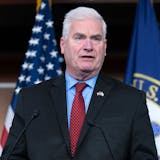What are you having for lunch today?
That usually isn't a political question, but for thousands of students in Minnesota's schools, it is. For them, the answer may depend on whether legislators now beginning their work in St. Paul can reach agreement on the Hunger-Free Schools campaign.
Gov. Tim Walz has taken the first step and included school meals for all in his proposal for how to use the state's $7.7 billion surplus. It will be up to the state House and Senate to determine its fate. As legislative decisions go, it should be an easy call.
The Hunger-Free Schools campaign's goal is straightforward: to provide a nutritious breakfast and lunch, free of charge, to every student in the state of Minnesota. And although the idea has the governor's support, it didn't start with him.
Our campaign has support from all parts of Minnesota's political spectrum and all corners of its geography. It's backed by a coalition of business partners and nonprofits that is literally too long to list here, but it includes some of the state's biggest employers. Among them are Blue Cross and Blue Shield of Minnesota and Cargill.
The money is available. With less than $200 million we can provide breakfast and lunch to all 900,000 K-12 students in Minnesota, at no cost to them. Remember, the budget shows a surplus of $7.7 billion, and projections suggest there is more to come.
Not only should the initiative be a no-brainer, financially and politically; it's also been proved doable — by virtue of its already having been done. Federal money made available for pandemic relief has gone to this exact purpose for the past two school years. Now, though, that money is about to dry up. It's time for the state to shoulder some of that responsibility.
You may be thinking, wait a minute — isn't there already a program that subsidizes school lunches? You're right, there is. And it works, up to a point. But a quarter of the kids who need that support don't qualify for it. The result is that some students eat well, while others are just getting by.



